Abstract
A CMOS differential-mode exponential voltage-to-current converter is presented which is based on the approximated Taylor's series expansion. The proposed circuit has been fabricated in a 0.5μm N-well CMOS process. Experimental results show that the output dynamic range of the proposed differential-mode exponential voltage-to-current converter can be 15dB while the nonlinear error is less than 1.35%. The experimental results are given to demonstrate the proposed circuits.
Similar content being viewed by others

References
A. Motamed, C. Hwang, and M. Ismail, “A low-voltage low-power wide range CMOS variable gain amplifier.” IEEE Trans. on Circuits Systems-II: Analog and Digital Signal Processing, vol. 45, no.7, pp. 800–810, 1998.
C. Lin, T. Pimenta, and M. Ismail, “Universal exponential function implementation using highly-linear CMOS V-I converters for dB-linear (AGC) applications,” in Proc. 1998 Midwest Symposium on Circuits and Systems, 1999, pp. 360–363.
C.C. Chang, M. Lin, and S.I. Liu, “CMOS current-mode exponential-control variable-gain amplifier.” Electronics Letters, vol. 37, pp. 868–869, 2001.
C.C. Chang and S.I. Liu, “Pseudo-exponential function using MOSFETs in saturation.” IEEE Trans. Circuits and Systems-II: Analog and Digital Signal Processing, vol. 47, pp. 1318–1321, 2000.
W. Liu, C.C. Chang, and S.I. Liu, “Realization of exponential V-I converter using composite NMOS transistors.” Electronics. Letters, vol. 36, no. 1, pp. 8–10, 2000.
S. Vlassis, “CMOS current-mode pseudo-exponential function circuit.” Electronics Letters, vol. 37, no. 8, pp. 471–472, 2001.
A. Motamed and M. Ismail, “CMOS exponential current-to-voltage converter.” Electronics Letters, vol. 33, no. 12, pp. 998–1000, 1997.
W. Liu and S.I. Liu, “CMOS exponential function generator.” Electronics Letters, vol. 39, no.1, pp. 1–2, 2003.
E.A.Vittoz, “Micropower techniques,” in Design of MOS VLSI Circuits for Telecommunications, edited by J. France and Y. Tsivids, Printice Hall, 1994.
E. Vittoz and J. Fellrath, “CMOS analog integrated circuits based on weak inversion operations.” IEEE Journal of Solid-State Circuits, vol. 12, no. 3, pp. 224–231, 1977.
Author information
Authors and Affiliations
Corresponding author
Rights and permissions
About this article
Cite this article
Liu, W., Liu, SI. & Wei, SK. CMOS Differential-Mode Exponential Voltage-To-Current Converter. Analog Integr Circ Sig Process 45, 163–168 (2005). https://doi.org/10.1007/s10470-005-4009-4
Received:
Revised:
Accepted:
Issue Date:
DOI: https://doi.org/10.1007/s10470-005-4009-4



